 |
 |
 |
| |
Abbott HCV Polymerase Inhibitor
|
| |
| |
Characterization of Pharmacokinetic/Pharmacodynamic Parameters
for the Novel HCV Polymerase Inhibitor A-848837
A.Molla1, R. Wagner1, L. Lu1, D. He1, C.-M. Chen1, G. Koev1, S. Masse1, Y. Cai1, C. Klein1, D. Beno1, L. Hernandez1, P. Krishnan1,
R. Pithawalla1, T. Pilot-Matias1, T. Middleton1, R. Lanford2, W. Kati1 and D. Kempf1
1Global Pharmaceutical Research and Development, Abbott, 200 Abbott Park Road, Abbott Park, IL, U.S.A.
22Department of Virology and Immunology, Southwest Foundation for Biomedical Research, San Antonio, Texas, U.S.A.
AUTHOR CONCLUSIONS
Multiple mutational patterns were observed in response to in vitro selection with A-848837 and several single mutations were shown to confer intermediate to high levels of resistance to the inhibitor.
The dominant resistance mutations selected in NS5B were C316Y and M414T in genotype 1a and M414T, Y448H, A553T, G554D and D559G in genotype 1b replicon.
The replication capacities of G554D, S368T, Y448H, D559G, A553T, and M414T were substantially lower than that of the corresponding wild-type replicon.
Treatment of replicon containing cells with A-848837 or SCH 503034 protease inhibitor alone at 10 X EC50 reduced HCV RNA levels 3 - 4 log copies in vitro whereas the combination of 5 X EC50 of both inhibitors together reduced HCV RNA over 7 logs, leading to undetectable HCV RNA within 12 days of treatment.
A-848837 is efficacious in the HCV-infected chimpanzee.
An escalating-dose protocol in chimpanzees can be used to estimate in vivo efficacy and may be more predictive of human efficacy than replicon potency. The plasma EC50 values of 0.13 - 0.38 _M were estimated for in vivo efficacy both in chimpanzee and human.
The preexisting mutations in replicon cells and the outgrowth of resistant viruses in the HCV infected chimpanzee suggest that this polymerase inhibitor would likely to need to be used in combination with a different class of inhibitor for optimal efficacy.
ABSTRACT
A-848837 is a selective inhibitor of HCV genotype 1 polymerases with EC50 values in the presence of 40% human serum of 28 and 62 nM against genotype 1b and 1a replicons, respectively. Following in vitro selection, replicon colonies were isolated which contained 1 - 3 mutations in the NS5B gene that were approximately 33- to >800-fold resistant to A-848837. Combination treatment of replicon cells with A-848837 and HCV protease inhibitor SCH 503034 reduced RNA to an undetectable level, "curing" the replicon. In the HCV-infected chimpanzee, plasma HCV RNA remained relatively constant with dosing from
1 to 20 mg and then declined significantly after escalation to 100 mg BID (measured trough concentration 0.28 _M). The liver to plasma drug concentration ratio was approximately 10:1. PK/PD analysis estimated an in vivo EC50 of 0.13 to 0.38 _M in plasma. Sequence analysis of plasma samples revealed C316Y/F, Y448C/H or G554D mutations in the NS5B polymerase gene. This study demonstrated that benzothiadiazine polymerase inhibitors are efficacious in the HCV-infected chimpanzee model. An escalating-dose protocol in chimpanzees can be used to estimate in vivo EC50 and may be more predictive of human
efficacy than the replicon EC50. The outgrowth of resistant viruses in the HCV 1a-infected chimpanzee suggests that this compound would likely need to be used in combination with a different inhibitor class.
Introduction
HCV has a high replication rate in vivo and its polymerase also has poor fidelity. Thus it is highly likely that drug-resistant HCV variants will emerge in patients treated with inhibitors of HCV polymerase. HCV replicons resistant to a number of inhibitors of the RNA-dependent RNA polymerase have been selected in vitro, and the specific amino acid substitutions within the NS5B gene associated with resistance to polymerase inhibitors have been identified.
A-848837 is a novel, specific inhibitor of the HCV polymerase and demonstrates excellent pharmacokinetics in animals, and following oral dosing, achieves high concentrations in liver, the primary site of HCV infection, with liver:plasma ratios ranging from 20:1 in rat to 200:1 in monkey. The development of anti-HCV therapy has been limited by the lack of a true viral infection system. The chimpanzee remains the best animal model susceptible to HCV infection. It is a useful model system to investigate the antiviral effect, pharmacokinetic properties, resistance profile and immune response of HCV inhibitors.
The PK/PD relationships for HCV inhibitors have not been defined. HCV replication occurs primarily in the liver; consequently, liver concentrations may be better predictors of efficacy than plasma levels. In order to better define efficacious plasma concentrations and quantify the development of resistance, A-848837 was studied in an HCV-infected chimpanzee.
OBJECTIVES
--Characterize the development of resistance both in vitro and in chimpanzees with the HCV polymerase inhibitor A-848837
--Identify the lowest effective dose of A-848837 in the chimpanzee model
--Define PK/PD relationship in the chimpanzee
--Estimate efficacious plasma concentrations in humans
METHODS
--The antiviral activity of A-848837 was determined by monitoring the levels of HCV RNA and/or SEAP activity using HCV subgenomic replicons.
--HCV resistant replicon variants were selected by culturing the HCV 1b-N strain in the presence of A-848837 at a concentration 10 times its EC50 in the presence of G418.
--Following in vitro passage, the NS5B polymerase gene was PCR-amplified from each resistant colony and population sequenced.
--Combination studies were performed by incubating replicon cells in the presence of single compound or combination of two compounds without G418.
----Cells were passaged every four days and HCV RNA copy number was determined at each passage.
--A genotype 1a-infected chimpanzee was dosed orally from 1 mg to 700 mg BID
in a scheme with dose escalation every 2 days for 10 days.
--Samples were periodically withdrawn after light sedation to determine viral load,
resistance and drug levels.
--The NS5B polymerase gene was PCR-amplified, and more than 65 clones were selected from each time point and sequenced.
--The plasma concentration time profile of A-848837 was modeled using trough
concentrations from the current study and Bayesian estimation using the time profile from a previous chimp PK study.
--Viral load kinetics were simulated using the equations of Neumann, et al., including sensitivity to different EC50 values to estimate the likely in vivo EC50.
Reference: Neumann, et al., Science 282, 103-107, 1998.
RESULTS
A-848837 is a highly potent inhibitor of HCV genotypes 1a and 1b (Table 1).
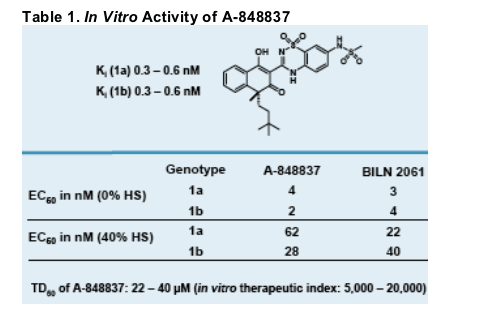
The highest levels of resistance were observed with the G554D single mutant in genotype 1b and C316Y together with I539M/I in genotype 1a. Other colonies were 33- to 106-fold resistant to A-848837 (Table 2).
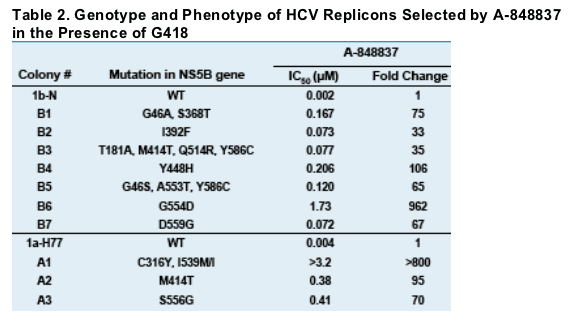
Recombinant single mutants G554D (genotype 1b replicon) and C316Y (genotype 1a replicon) exhibited 255- to 2868-fold reduced susceptibility to A-848837 in a transient transfection assay (Table 3).
Mutants resistant to A-848837 remain susceptible to IFN, BILN 2061 (HCV protease inhibitor), and a thiophene HCV polymerase inhibitor (Table 3).
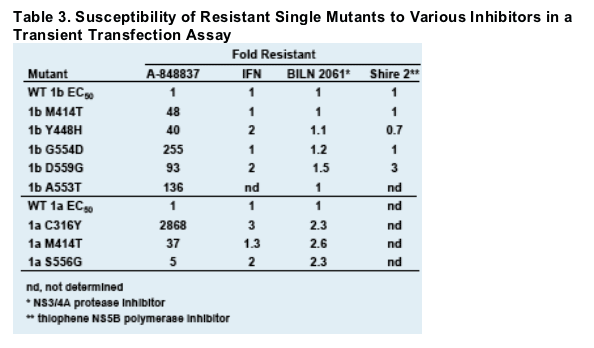
The replication capacities of all mutant replicons with the exception of I392F were
substantially impaired compared with the wild-type replicon (Figure 1).
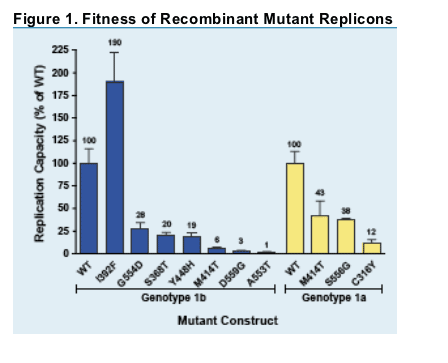
Treatment of the 1b replicon with IFN at 10 X EC50 produced <1.0 log10 HCV RNA decline at passage 2 whereas treatment with either A-848837 or SCH 503034 at 10 X EC50 produced > 3.5 log10 RNA decline (Figure 2).
The combination of 5X EC50 SCH 503034 plus 5X EC50 A-848837 displayed an apparent synergistic effect. Simultaneous treatment with both drugs was able to reduce RNA to an undetectable level after passage 4 (Figure 2).
No resistant colonies were identified when neomycin was added at passage 5 indicating that replicon cells were cured by the combination treatment (Figure 2).

Plasma HCV RNA remained relatively constant in the treated chimpanzee through the first three dosing periods (1, 5, and 20 mg BID), then declined significantly after the dose was escalated to 100 mg BID (trough concentration 0.28 _M; Figure 3, Table 4).
Viral load continued to decline at the 700 mg BID dose (Figure 3).
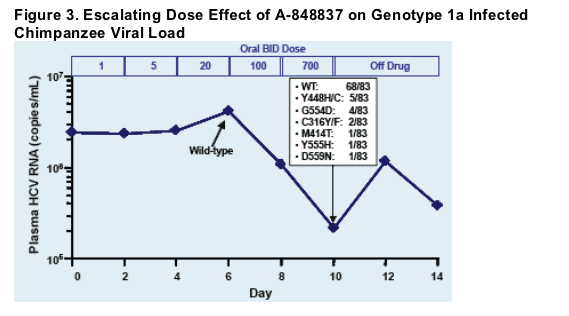
From trough concentrations the overall pharmacokinetic profile in the chimpanzee was estimated. The predicted plasma trough concentrations were close to those observed in chimpanzee (Figure 4, Tables 4 and 5).
The liver to plasma drug concentration ratio was approximately 10:1 and assumed to be constant (Table 4).

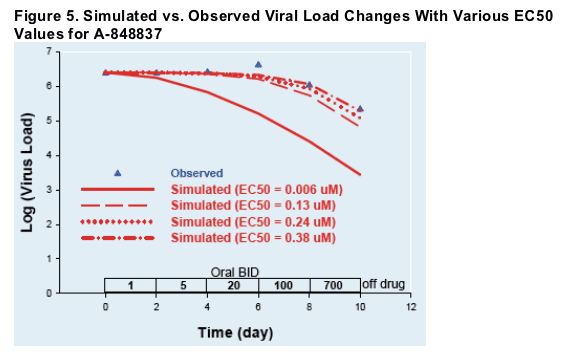
|
| |
|
 |
 |
|
|